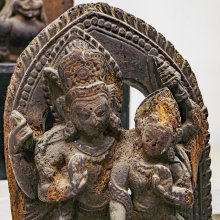Lap: 12 definitions
Introduction:
Lap means something in Hinduism, Sanskrit, Hindi, biology. If you want to know the exact meaning, history, etymology or English translation of this term then check out the descriptions on this page. Add your comment or reference to a book if you want to contribute to this summary article.
Images (photo gallery)
(+37 more images available)
In Hinduism
Yoga (school of philosophy)
Source: ORA: Amanaska (king of all yogas): A Critical Edition and Annotated Translation by Jason BirchThe Lap is denoted by the Sanskrit term Aṅka, according to the Parākhyatantra verse 14.8-9.—Accordingly, while discussing preliminary practices to make the Yogin ready to undertake the six auxiliaries of Śaiva yoga: “He should adopt one of these [four poses], placing his hands with the palms arranged [facing upwards] in his own lap (aṅka-gata), expanding his chest evenly. Slightly closing his two eyes, he should focus on the tip of his nose. Remaining thus he is fit for yoga and he should then begin its sequence”.

Yoga is originally considered a branch of Hindu philosophy (astika), but both ancient and modern Yoga combine the physical, mental and spiritual. Yoga teaches various physical techniques also known as āsanas (postures), used for various purposes (eg., meditation, contemplation, relaxation).
Biology (plants and animals)
Source: Google Books: CRC World Dictionary (Regional names)Lap in India is the name of a plant defined with Heteropogon contortus in various botanical sources. This page contains potential references in Ayurveda, modern medicine, and other folk traditions or local practices It has the synonym Andropogon allionii Lam. & DC. (among others).
Example references for further research on medicinal uses or toxicity (see latin names for full list):
· Botanische Jahrbücher für Systematik, Pflanzenge schichte und Pflanzengeographie (1885)
· The Flora of British India (1864)
· Journal of Cytology and Genetics (1990)
· Acta Botanica Indica (1990)
· Boletim da Sociedade Broteriana (1885)
· Flore de France, ed. 3 (1805)
If you are looking for specific details regarding Lap, for example chemical composition, extract dosage, side effects, pregnancy safety, health benefits, diet and recipes, have a look at these references.

This sections includes definitions from the five kingdoms of living things: Animals, Plants, Fungi, Protists and Monera. It will include both the official binomial nomenclature (scientific names usually in Latin) as well as regional spellings and variants.
Languages of India and abroad
Sanskrit dictionary
Source: DDSA: The practical Sanskrit-English dictionaryLap (लप्).—1 P. (lapati)
1) To speak, talk in general.
2) To prate, chatter.
3) To whisper; कपोलतले मिलिता लपितुं किमपि श्रुतिमूले (kapolatale militā lapituṃ kimapi śrutimūle) Gītagovinda 1.
4) To wail, lament. -Caus. (lāpa- yati-te) To cause to talk &c. With उद् (ud) to call out loudly to.
Source: Cologne Digital Sanskrit Dictionaries: Shabda-Sagara Sanskrit-English DictionaryLap (लप्).—[(ṛ) lapṛ] r. 1st cl. (lapati) To speak, to utter. With anu prefixed. 1. To talk like, to mimic. 2. To repeat. With apa, To deny. With āṅ, To address, to speak to. With pra, To talk incoherently. With prati, To gain, to get. With vi, To lament, to bewail. With vi and pra, To contradict, to dispute. With sam, 1. To converse, to discourse. 2. To be cunning or crafty.
Source: Cologne Digital Sanskrit Dictionaries: Benfey Sanskrit-English DictionaryLap (लप्).—i. 1, [Parasmaipada.] (in epic poetry also [Ātmanepada.], [Nala] 21, 16). 1. To speak, [Gītagovinda. ed. Lassen.] 1, 41. 2. To lament, [Nala] 3, 27. Ptcple. of the pf. pass. lapitā, n. Voice. Frequent. lālap, lālapya, To lament, Mahābhārata 3, 10200. lālapya, [Parasmaipada.], Mahābhārata 1, 968.
— With the prep. apa apa, To deny, [Rāmāyaṇa] 2, 75, 24.
— With ā ā, To address, Mahābhārata 3, 15604. [Causal.] lāpaya, To ask, [Pañcatantra] i. [distich] 431; 242, 13.
— With pra pra, 1. To prattle, [Śākuntala, (ed. Böhtlingk.)] 13, 14. 2. To speak, [Pañcatantra] 94, 12; to cry, Böhtl. Ind. Spr. 309. 3. To bewail, [Pañcatantra] 75, 25; Mahābhārata 3, 1203. 4. To invoke, Mahābhārata 2, 2339. pralapita, n. 1. Prattle, [Pañcatantra] 146, 1 (vṛthā-, Useless words). 2. Lamentation, Pañc, 224, 16. [Causal.] To incite to speak, [Mṛcchakaṭikā, (ed. Stenzler.)] 86, 14.
— With vi vi, 1. To wail, [Hitopadeśa] 44, 6, M.M.; Mahābhārata 3, 1203. 2. To bewail, [Rāmāyaṇa] 1, 1, 52. 3. To speak, [Johnson's Selections from the Mahābhārata.] 51, 110.
— With sam sam, To converse, [Daśakumāracarita] in
— Cf. [Latin] loqui; probably (a [denominative.] based on an old [frequentative.] and aff. van, with for )
Source: Cologne Digital Sanskrit Dictionaries: Cappeller Sanskrit-English DictionaryLap (लप्).—lapāta (lapāte) [participle] lapita (q.v.) chatter, prate, talk, lament. [Causative] lāpayati cause to talk. [Intensive] lālapīti chatter senselessly, prattle, lālapyate (ti) wail, lament.
Source: Cologne Digital Sanskrit Dictionaries: Monier-Williams Sanskrit-English Dictionary1) Lap (लप्):—1. lap (cf. √rap) [class] 1. [Parasmaipada] ([Dhātupāṭha x, 8]) lapati ([Epic] also te and lapyati; [perfect tense] lalāpa, lepus, [Mahābhārata] etc.; [Aorist] alāpīt [grammar]; [future] lapitā, [ib.]; lapiṣyati, [Brāhmaṇa] etc.; [infinitive mood] laptum, [Mahābhārata]; lapitum, [Kāvya literature]; [indeclinable participle] -lapya, [Mahābhārata]),
—to prate, chatter, talk (also of birds), [Mahābhārata; Harivaṃśa];
—to whisper, [Gīta-govinda; Pañcarātra];
—to wail, lament, weep, [Nalôd.] :—[Causal] lāpayati, te ([Aorist] alīlapat or alalāpat [grammar]), to cause to talk, [Chāndogya-upaniṣad] :—[Desiderative] lilapiṣati [grammar]:—[Intensive] lālapīti, to prate senselessly, [Atharva-veda; Kāṭhaka];
— lālapyate (mc. also ti), to wail, lament, [Mahābhārata; Rāmāyaṇa; Mārkaṇḍeya-purāṇa];
—to address repeatedly, [Mahābhārata], lālapti [grammar]
2) cf. [Greek] ὀ-λοφ-ύρομαι ; perhaps [Latin] lāmentum for lap-mentum.
3) 2. lap (ifc.) speaking, uttering (See abhilāpalap).
Source: Cologne Digital Sanskrit Dictionaries: Yates Sanskrit-English DictionaryLap (लप्):—lapati 1. a. To speak. With apa to deny; ā to address; pra to talk incoherently; prati to gain; vi to lament; saṃ to converse; vi and pra to contradict, dispute.
Source: DDSA: Paia-sadda-mahannavo; a comprehensive Prakrit Hindi dictionary (S)Lap (लप्) in the Sanskrit language is related to the Prakrit word: Lava.
[Sanskrit to German]
Sanskrit, also spelled संस्कृतम् (saṃskṛtam), is an ancient language of India commonly seen as the grandmother of the Indo-European language family (even English!). Closely allied with Prakrit and Pali, Sanskrit is more exhaustive in both grammar and terms and has the most extensive collection of literature in the world, greatly surpassing its sister-languages Greek and Latin.
Hindi dictionary
Source: DDSA: A practical Hindi-English dictionaryLap in Hindi refers in English to:—(nf) elasicity; a sound produced by moving a stick forcefully in the air or by a dog etc. while drinking water; palmful of anything; ~[jhapa] unsteady, fidgety; agility; ~[lapa karana] to produce [lapalapa] sound by moving a stick forcefully in the air or by a dog etc. while drinking water; —[se] at once, quickly..—lap (लप) is alternatively transliterated as Lapa.
...
See also (Relevant definitions)
Starts with (+183): Lapa, Lapa-lapa, Lapacho amarillo, Lapadisu, Lapak, Lapak-lapak, Lapaka, Lapakana, Lapakka, Lapakkenal, Lapakna, Lapalapa, Lapalapa adete, Lapalapa la, Lapalapa pupa, Lapalapalipalipa, Lapalapana, Lapalapaunu, Lapalape, Lapalip.
Ends with (+31): Aalap, Abhilap, Abhilapalap, Alap, Alapavilap, Alaplap, Aoelglap, Apalap, Atu-tinlap, Barkhilap, Brazilian jalap, Chersialap, Chinenlap, Dewlap, Dieng-sohtyllap, False jalap, Fusiform jalap, Galap, Glap, Golap.
Full-text (+432): Utsanga, Anka, Lapana, Lava, Alapin, Lapa, Vilapa, Ullapa, Pralapana, Vilapana, Lapita, Abhilapa, Upastha, Lapay, Abhilapalap, Svanka, Lapya, Alapana, Ullapin, Alih.
Relevant text
Search found 177 books and stories containing Lap; (plurals include: Laps). You can also click to the full overview containing English textual excerpts. Below are direct links for the most relevant articles:
Garga Samhita (English) (by Danavir Goswami)
Verse 1.17.3 < [Chapter 17 - Description of the Yogurt Theft]
Verse 2.8.17 < [Chapter 8 - Description of Seeing Lord Kṛṣṇa]
Verse 1.13.5 < [Chapter 13 - The Liberation of Pūtanā]
Mahabharata (English) (by Kisari Mohan Ganguli)
Section XLII < [Sisupala-badha Parva]
Section LIX < [Sanatsujata Parva]
Section 24 < [Stri-vilapa-parva]
Chaitanya Bhagavata (by Bhumipati Dāsa)
Verse 1.4.59 < [Chapter 4 - Name-giving Ceremony, Childhood Pastimes, and Thieves Kidnap the Lord]
Verse 1.4.61 < [Chapter 4 - Name-giving Ceremony, Childhood Pastimes, and Thieves Kidnap the Lord]
Verse 1.5.61 < [Chapter 5 - Eating the Mendicant Brāhmaṇa’s Offerings]
Trishashti Shalaka Purusha Caritra (by Helen M. Johnson)
Part 1: Childhood of Ajita and Sagara < [Chapter III - The initiation and omniscience of Ajita]
Part 9: Birth of Padma (Rāma) and Lakṣmaṇa < [Chapter IV - The, birth, marriage, and retreat to the forest of Rāma and Lakṣmaṇa]
Part 8: Sanatkumāra’s childhood < [Chapter VII - Sanatkumāracakricaritra]
Song 2 < [Janma-līlā (birth pastimes)]
Song 26 < [Śacī-mātār Śoka (Mother Śacī’s Grief)]
Song 3 < [Bālya-līlā (Ages 1-5—Pastimes)]
Bhakti-rasamrta-sindhu (by Śrīla Rūpa Gosvāmī)
Verse 3.4.74 < [Part 4 - Parenthood (vātsalya-rasa)]
Verse 2.4.121 < [Part 4 - Transient Ecstatic Disturbances (vyābhicāri-bhāva)]
Verse 3.4.46 < [Part 4 - Parenthood (vātsalya-rasa)]





